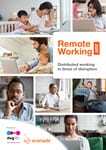20 areas organizations need to consider to embed remote working in the long term
The mid- to long-term impact
The coronavirus has had an immediate impact on the way we work, with a spectacular and almost overnight introduction of home working for millions of office-based workers. If organizations were planning such a roll-out of distributed working on this scale in normal times, it would be a year-plus project, with many strategic, operational, technical and cultural factors taken into consideration. Of course, during this crisis no one has had that luxury – and leaders, support teams and employees are doing their best to navigate the challenges.
At the moment we simply don’t know how long measures that support social distancing will be in place. It may be weeks or months and, even if lifted, the restrictions may have to be reintroduced. Leadership and digital workplace teams need to be thinking about the medium term and even the long term when it comes to embedding remote working, not only to be able to deal with a sustained crisis but also potentially to meet the demands of the “new normal”. In our view, the current crisis is a game-changer, which has the potential to normalize and increase the instances of remote working going forward.
There are multiple areas that will be both impacted by and need to change in order to embed remote working in the digital workplace in the long term. Here are 20 areas that digital workplace teams need to consider.
1. Tools and infrastructure
This is perhaps the most obvious area of change. Do individuals and teams have the right digital workplace tools and equipment to allow them to work remotely? Is there a satisfactory infrastructure in place to support remote working at scale? Many of these may emerge during the crisis itself, and we already know a number of organizations who are bringing forward plans for MS Teams. Once the dust settles and the crisis is over, a more considered review of the tools and hardware in place will be required.
2. The physical office
With more distributed work, physical offices will almost certainly need more tools and meeting spaces suited to remote collaboration. Meeting rooms are generally optimized for virtual meetings, but there may be other impacts. Offices are already designed to facilitate collaboration and different types of work, for example, creating impromptu places for people to sit and collaborate. A classic situation would be if a third person working remotely wants to join an impromptu meeting. Does everyone involved now need to go online? Is there a way to minimize the sound from an informal meeting such as this? Physical office space will also be influenced in the longer term by any reduction in the number of people coming to the office.
3. HR policies and guidelines
An obvious change will be in the HR policies that support remote working. These are often already present, laying down a formal process for home-based employees, but may need to start defining more specific rules of engagement around distributed work. We expect such policies already to have been defined and refined during the crisis, but they may later need to be modified to cater for a longer-term, more strategic view.
4. Support functions
Most large enterprises have support help desks for IT and HR, which might include a ticketing system, self-service resources or, increasingly, chatbots to help drive efficiency. Support functions and related help desks may have to recalibrate their service offerings to meet the needs of homeworkers, not just in the way the help desk is accessed, but also in the questions and issues covered.
In single-location companies, a high proportion of IT support is carried out face to face, so more tools may need to be put in place to offer remote support.
5. Data security
Data security is already a significant activity for IT functions and they may need to add measures or processes to minimize the risks associated with remote working on scale. At the heart of this may be a need for more user training and awareness.
6. Resourcing and budgets
After the crisis is over, there is a chance that more people will continue to work from home. More budget may be needed to invest in the right software, equipment and training to properly embed remote working. Some organizations may also choose to provide resourcing for coordination and governance to be put in place; for example, the United States Patent and Trademark Office (USPTO), which has a mature and sector-leading remote working programme, has a dedicated Telework Program Office.
7. Business continuity
Business continuity plans lean on remote working as a way to keep things up and running in the face of a disaster, but not all organizations will have planned for a sustained global pandemic on the scale of the current crisis. This is an obvious area where all future plans will be reviewed, both in the light of this kind of crisis but also because new routines and capabilities will almost certainly have been created.
8. Digital literacy
Digital literacy initiatives help employees to use the digital tools at their fingertips – not just the “how” but also the why, the what and the new ways of working that digital tools facilitate. A successful initiative also shows best use of tools and gives employees confidence to get results from the digital workplace. Inevitably, digital literacy training will need to place greater emphasis on home and remote working.
9. Management roles
The crisis and sustained remote working undoubtedly place pressure on managers to step up. Among other things, there is a greater emphasis on project management, empathy and listening, and criteria for performance management. The roles of managers and the training they require have shifted – and will need to shift further still.
10. Meetings
The crisis has seen the overnight switch from physical meetings to virtual meetings. Most teams already conduct some virtual meetings, but a complete switch can still feel different. Teams will quickly discover new good practices, what works for them, and how to navigate the shift in the dynamic of a virtual meeting.
After the crisis is over, it is quite possible there will be more frequent virtual meetings, better tools and increased support. Physical meeting spaces may need to be better optimized, for example, with more thought given to the positioning of cameras and how audio is relayed.
11. Health and wellbeing
Health and wellbeing is a significant issue for people who work from home. This can relate to stress, loneliness, feeling disconnected from colleagues, working overly long hours, as well as ergonomic issues such as not having the right desk or chair set-up. Fitting in exercise can also be a challenge. Overall, a distributed workforce has different physical and emotional health and well-being needs than those working full-time in offices. Many organizations already have extensive health and wellbeing programmes, and these will need to take into account some of the unique issues related to distributed working. Naturally there will also be considerable stress associated with the crisis.
12. Performance management and reviews
With distributed working, performance management can shift subtly towards being more based on agreed output rather than closely supervised goals stipulated by a manager to an employee. All too often, employee appraisals are influenced by working styles or presence in the office rather than actual results. Distributed working inevitably moves performance management to being much more about the quality of what has been delivered rather than how the individual chose to deliver it, in our view a positive outcome that is built on trust.
13. Workplace metrics
Workplace metrics is a growing area where people want to use data and reporting to gain insights into everything from employee sentiment to how to increase productivity. The sudden rise of remote working does mean that more work is being done online, potentially producing more data than may reveal insights. The nature of the metrics may also change to take into account the new working style.
14. Leadership
The impact of the crisis and the circumstances of working from home may produce changes in leadership style to being more about listening and dialogue, and increasingly human-centred, personal and authentic. The perception of leaders may also change profoundly too, with employees feeling they are closer to the leadership than ever before. Post-crisis leaders may be viewed differently.
15. Deskless and firstline workers
Within some sectors, such as manufacturing, retail, leisure, healthcare and travel, most employees are not based in offices and cannot work remotely. If home working does become far more normalized and a key part of an employment value proposition, it is possible it could also positively impact non-office workers. For example: Could any administration be done remotely? Will there be more virtual collaboration between employees on site and employees working from home?
16. Regional and global balance
Traditionally, there is tension in large organizations between the centre (HQ) and different divisions, locations or subsidiaries. Global functions want to standardize processes and ways of working, while local functions want to do things their own way. Local divisions or offices can also be disadvantaged, say in terms of budget spent on them.
When everyone works from home, the idea of there being a global HQ or a central function can dissipate slightly because everyone is working in the same way. Suddenly, individual location becomes less important. A sustained period of everyone working from home may influence a better global and regional balance, and reduce tensions that appeared in the past.
17. Testing
Informally, as the Coronavirus crisis deepens, we’ve seen companies start to test some of their online tools to see, for example, how they cope with a larger distributed workforce accessing them. From software releases through to business continuity, if more extensive distributed work is here to stay, then more and more testing will need to be carried out to ensure the tools can be accessed by a remote workforce.
18. Strategic planning
The huge rise in remote working and the pandemic will undoubtedly impact strategic planning, not only in building organizational resilience but also as regards considerations of how to take something positive from the crisis for the future.
19. Recruitment
If distributed working does become more normalized, this may start to impact recruitment patterns. Distributed working opens up a potentially much wider talent pool as well as supporting diversity and inclusion. This will impact recruitment policies if companies want actively to recruit a distributed workforce, and may even influence the selection of employees and success criteria – is your candidate the type of person that could work well at home?
20. Culture and attitudes
Make no mistake, this crisis will have a profound impact on the way we work, our relationships with people close to us as well as far away from us, and how we feel about our work. A crisis like this and how we navigate it together can have a profound influence on organizational culture and attitudes to how we work and to our colleagues. If there is anything positive that may come out of this crisis, it may be a warmer, friendlier and more human-centred organizational culture.
To the future
This is an unprecedented situation with a lot of unknowns along the way, but we will get through it. The future will involve greater capabilities to support remote working with the digital workplace playing a key role. I personally look forward to the time when we can fully consider how to embed remote working within organizations for the true long term and not through the lens of this crisis.
Take the next step…
Remote Working 2020  | Become a DWG Member |
Categorised in: Collaboration, Digital workplace, Internal communications, Remote working during COVID-19, ROI & Business Case, Strategy & governance


